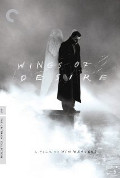
Germany/France 1987
Directed by
Wim Wenders
128 minutes
Rated M
Reviewed by
Bernard Hemingway

Wings Of Desire
In what is a kind of gloomily Teutonic companion piece to Capra’s It’s A Wonderful Life Bruno Ganz and Otto Sander play a couple of angels, Damiel and Cassiel, who wander the streets of Berlin eavesdropping on the melancholy musings of divers individuals. Damiel is so taken with the desire to experience the joys and pains of real existence, in particular the favours of a beautiful French trapeze artist (Solveig Dommartin) that he incarnates (and chooses a really hideous jacket in which to do so). Meanwhile Peter Falk, who is Berlin to make a movie about Nazis, wanders around looking for a good hat and some old codger named Homer (Curt Bois) muses on the death of culture and good story-telling.
Many would remark on the visual resemblance of Wenders' film to Jean Cocteau's Beauty And The Beast, something which is no accident as Wenders persuaded its cinematographer, Henri Alekan, to come out of retirement to lens his film. It was a stroke of genius, for the endlessly prolix script by Wenders and Peter Handke, like the angels, meanders all over the place to little effect, even at one point managing to fit in a performance by Antipodean art-rockers, Nick Cave and The Bad Seeds.
As a way of addressing the duality of human experience the notion of angelic visitation is an attractive concept, but for all the supposed celebration of the goodness of the simple things of life, the film's pre-Berlin Wall Fall, post Nazi glumness feels like a dated wallow in a few loose ideas that never achieve any dramatic affect but rather stylishly repackages the work of the masters of cinema such as Fellini (for the circus motif) and Bergman (for the hand-wringing alienation) for its (now past) time.
Want something different?





